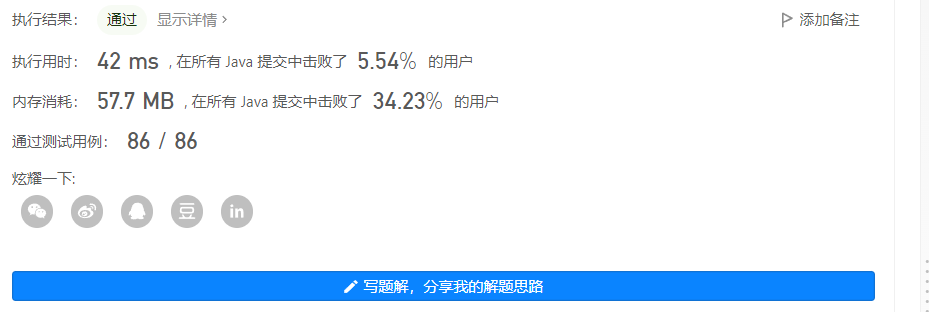leetCode–234(回文串)
给你一个单链表的头节点 head ,请你判断该链表是否为回文链表。如果是,返回 true ;否则,返回 false 。
示例 1:

1
2
| 输入:head = [1,2,2,1]
输出:true
|
示例 2:

1
2
| 输入:head = [1,2]
输出:false
|
解法一:自己,使用栈完成
使用栈来存储遍历的链表,后依次出栈,和链表比较。
太低了吧!! 哈哈哈 加油加油!

代码为:
1
2
3
4
5
6
7
8
9
10
11
12
13
14
15
16
17
18
19
20
21
22
23
24
25
26
27
28
29
30
31
|
class Solution {
public boolean isPalindrome(ListNode head) {
if (head==null) return true;
if (head.next==null) return true;
if (head.next.next==null && head.val==head.next.val) return true;
else if (head.next.next==null && head.val!=head.next.val) return false;
Stack<ListNode> stack = new Stack<>();
ListNode cur = head;
while (cur!=null){
stack.push(cur);
cur = cur.next;
}
cur = head;
while (cur!=null){
if (cur.val!=stack.peek().val) return false;
else stack.pop();
cur = cur.next;
}
return stack.isEmpty();
}
}
|
解法二:双指针
将链表中的元素存储在list集合中,定义两个前后指针,遍历list,对前后指针的元素进行比较。
- 如果是回文链表,则前后指针指向的元素值相等,继续移动 l++,r–。
- 如果前后指针指向的元素不相等,则直接返回false。
1
2
3
4
5
6
7
8
9
10
11
12
13
14
15
16
17
18
19
20
21
22
23
24
25
26
27
28
29
30
31
32
|
class Solution {
public boolean isPalindrome(ListNode head) {
List<Integer> list = new ArrayList<>();
ListNode cur = head;
while (cur!=null){
list.add(cur.val);
cur = cur.next;
}
int l = 0;
int r = list.size()-1;
while (l<r){
if (list.get(l)!=list.get(r)) {
return false;
}else {
l++;
r--;
}
}
return true;
}
}
|
解法三:递归
递归遍历每个节点,前面的那些节点已经在栈中存储了,当到最后一个节点的时候停止,和head元素比较。
通过递归的特性,是由后向前比较,而头结点也依次的向后移动。
算法的正确性在于递归处理节点的顺序是相反的(回顾上面打印的算法),而我们在函数外又记录了一个变量,因此从本质上,我们同时在正向和逆向迭代匹配。
代码为:
1
2
3
4
5
6
7
8
9
10
11
12
13
14
15
16
17
18
19
20
21
22
23
24
25
26
27
|
class Solution {
private ListNode t;
public boolean isPalindrome(ListNode head) {
t = head;
return check(head);
}
public boolean check(ListNode head){
if (head!=null){
if (!check(head.next)) return false;
if (head.val!=t.val) return false;
t =t.next;
}
return true;
}
}
|
解法四:快慢指针+链表逆转
使用快慢指针在一次遍历中找到:慢指针一次走一步,快指针一次走两步,快慢指针同时出发。当快指针移动到链表的末尾时,慢指针恰好到链表的中间。通过慢指针将链表分为两部分。
将分割后的第二部分进行链表逆转,
比较两个部分的值,当后半部分到达末尾则比较完成。
代码为:
1
2
3
4
5
6
7
8
9
10
11
12
13
14
15
16
17
18
19
20
21
22
23
24
25
26
27
28
29
30
31
32
33
34
35
36
37
38
39
40
41
42
43
44
45
46
47
48
49
50
51
52
53
54
55
56
|
class Solution {
public boolean isPalindrome(ListNode head) {
if (head==null) return true;
ListNode first = merge(head);
ListNode second = revList(first.next);
ListNode p1 = head;
ListNode p2 = second;
boolean result = true;
while (result && p2!=null){
if (p1.val!=p2.val) result = false;
p1 = p1.next;
p2 = p2.next;
}
return result;
}
public ListNode revList(ListNode node){
ListNode pre = null;
ListNode cur = node;
ListNode next;
while (cur!=null){
next = cur.next;
cur.next = pre;
pre = cur;
cur = next;
}
return pre;
}
public ListNode merge(ListNode head){
ListNode slow = head;
ListNode fast = head;
while (fast.next!=null && fast.next.next!=null){
fast = fast.next.next;
slow = slow.next;
}
return slow;
}
}
|


